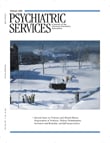Commentary: Reducing Restraint and Seclusion: A View From the Trenches
This is a new era for inpatient psychiatric treatment. The vast majority of inpatient episodes today are short term (less than seven days), and patients are admitted to the hospital primarily to reduce harm to themselves or others. The primary criterion for admission and discharge is focused on risk and dangerousness. Inpatient treatment today is crisis stabilization, reevaluation of medication and psychosocial interventions, and prompt discharge. Most treatment occurs outside of the hospital in day hospitals, outpatient treatment, supported housing, and other community-based programs.
As a result, most units in general hospitals as well as specialty psychiatric hospitals have acutely ill patients, many of whom are aggressive, and care takes place most often on locked units where restraint and seclusion are used as emergency management responses to violent behaviors that jeopardize physical safety. Oversight of restraint and seclusion by regulatory agencies, such as the Centers for Medicare and Medicaid Services and the Joint Commission on Accreditation of Healthcare Organizations, reemphasizes their appropriate use.
The view from one hospital (Sheppard Pratt) is a bit more nuanced. It is obvious that inpatient care must have the safety of patients and staff as its top priority so that the major task of crisis stabilization can proceed effectively and efficiently and so recruitment and retention of high-quality nursing staff can occur. Staff retention and turnover are constant problems in our hospital and in many acute care settings. In fact, the greatest risk is the risk of self-harm—patient self-injury and, more rarely, inpatient suicide remain major challenges for all inpatient facilities. For staff, the potential of assault by patients is a major risk to other patients and staff. Therefore, increasing the ability of staff to anticipate and prevent aggressive events is critical to avert injury. At our hospital we have moved away from an emphasis on the proper use of restraint and seclusion to an emphasis on reducing their use by changing the culture of the inpatient stay and by developing tools and techniques to prevent aggressive episodes from ever escalating to the point of needing an intervention that requires restraint or seclusion. Reducing violence and aggression will reduce restraint and seclusion. Interventions that reduce violence not only improve safety but also improve the treatment experience for patients and families.
This requires strong leadership from the top down. It means finding new ways of hiring, orienting, and mentoring staff to embrace a different culture. It involves using timely data to track progress. It requires hiring former patients (consumers) to help in the training and debriefing process. We review each restraint and seclusion situation to see what can be learned to prevent aggression from escalating into another episode. Reducing seclusion and restraint requires asking patients about "triggers" before episodes of seclusion and restraint and also asking them what can be done to avoid aggressive confrontations. Debriefings are formalized and involve leadership in the organization. This is no quick fix; it requires ongoing and continuous attention.
In our hospital in Baltimore with nearly 7,500 admissions per year, we have been successful in dramatically reducing seclusion and restraint. We have developed the SPARC campaign—Sheppard Pratt Aggression Reduction Campaign—and have celebrated our successes along the way. Episodes of seclusion and restraint have dramatically decreased but have not yet been eliminated.
A very small number of patients pose the highest risk of aggression and potential use of restraint and seclusion. Not admitting these patients—screening them out of the psychiatric hospital stay—is potentially the most effective way to reduce and eliminate the use of restraint and seclusion and to lower the level of aggression on inpatient units. The problem with this approach is that it will expose more individuals with psychiatric disorders to homelessness, criminalization, and incarceration in jails and prisons. We already have a major public health crisis in the numbers of persons with mental illness who are in jails and prisons. In our effort to make hospitals free of restraint and seclusion, we could add to this problem by refusing to admit individuals with a history of violence or prior episodes of restraint and seclusion.
With that caveat in mind, it is incumbent on psychiatric hospital leaders to make every effort to exceed the regulatory or oversight expectations and ensure the safety of an acute inpatient stay by reducing restraint and seclusion. Elimination of restraint and seclusion should be a goal, but it may be difficult to accomplish if we endeavor to treat individuals with acute psychosis who have a history of violence and whose recent violent behavior has led to hospitalization. Safety is the top priority. Without safety, there is no treatment.



